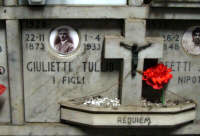
Introduction
by Gregg Miner This story is yet another wonderful rare glimpse into the lives, careers and instruments of forgotten harp guitar players and luthiers. It is made possible by the secondary story: the friendship of the author with the last surviving member of the Giulietti "harp guitar dynasty," a little-known family of father and two sons, all of whom either built or played harp guitars during the long heyday of the Italian "flying basses guitars." Both sons Armando and Giulio became musicians who followed in their father Tullio's footsteps as, respectively, a guitar builder and a guitar player. As was common for Italian guitarists of the early 20th century, instruments with floating sub-bass string were popular and the Giulietti clan embraced them as well, in both hollow arm and theorboed variants. We are indebted to Roger Belloni for so meticulously organizing his memories and sharing his photographs to preserve and share this untold harp guitar story. Some of the more interesting revelations to me were:
I would also like to specifically thank Marco Bazzotti, Antonello Saccu and Franco Ghisalberti for sharing additional Giulietti material with us, and Marco for the important Italian translation. |
||||||||
| Tullio
Giulietti Tullio
Giulietti
was born in
These
entries are interesting though limited and flawed. |
Tullio
Giulietti, circa 1918, with his personal harp guitar, |
 |
Tullio is buried in the Milan Cemetery at Piazzale Cimitero Maggiore, 20156 Milano MI, the vault located at "Reparto 34 Ossiario 1928 IV fila inferiore" |
|
|
Armando
Giulietti
Armando
Giulietti was born in Rome
in 1903. He
started working in his father’s workshop at an early age and built a
guitar entirely by himself at the age of 16. He
also became a cello professor, teaching and performing mostly in opera
productions as first soloist. Many
stories regarding himself and his father were related to me personally
after we were introduced by mutual friends in the early 1970's.
His memory was excellent until the last year of his life (1990) and the anecdotes
were detailed and rich. As an example, here's why we have no recordings of Tullio's music (this story also explains why the members of this family were highly thought of but handled with care as they had a charming but almost Django-like personality). Tullio was scheduled to make records for the prestigious Fonit Cetra label but while the first track was being recorded someone shut a window and ruined the take. Tullio patiently resumed the session but this time somebody slammed a door. At this point he just stood up saying "That's enough, I don't need this aggravation or your records" and stormed out depriving us of a glimpse into his musical world! |
|
Left: Armando Giulietti with the author in 1989 |
| Tullio’s
son Giulio played a
hollow arm instrument
similar to his father's that was built by Armando (probably like the one
in the
Monzino collection,
shown below).
Giulio
recorded with it and I saw the 78's but never heard them. In
the post war years Armando concentrated almost exclusively on
Torres-style guitars and was awarded first prize with the highest honors
at the |
|
|
|
Left: Another 7-bass hollow arm harp guitar, this one built in 1938 for Monzino & Sons. Instruments of both Tullio and Armando were sold through the Monzino shop in Milan. |
|
Below: Two advertisements from guitar magazines, courtesy of Marco Bazzotti, and a Armando's letterhead on a note to the author |
|
| My
Giulietti Guitars After
meeting Armando I ordered a folk guitar which he based on a modernized
Guadagnini pattern. I played it in |
The author in Armando's shop in 1975 |
|
During
my long stay in the |
|
| Footnote Sometime
before I acquired the harp guitars, while I was still in Update, April, 2011: Rare Recordings by Giulio Giulietti discovered! See the Harpguitars.net Members Only Section to listen! |
|
|
ABOUT THE AUTHOR
|
A native of Milan, Italy, Roger Belloni began his professional career in Cambridge, England, where, after playing in all the local clubs, he appeared at the prestigious Folk Festival at the age of 19. He then managed his own club in Italy and toured extensively all over Europe until, during an engagement at the famous Jazzland in Vienna, Austria, he met renowned Bluesman John Jackson, who invited him to the U.S. Roger has performed at countless clubs and festivals and on radio and TV in the U.S., Italy, Switzerland and Mexico. Most notably, he was selected by Blues expert and Robert Johnson historian Steve La Vere to open the first San Diego Black Music Festival and by record collector Lou Curtiss to conduct a guitar workshop with Sam Chatmon, half-brother of legendary Charlie Patton. During his nearly 20 year stay in the U.S., Roger has been chiefly influenced by North Carolina guitarist Bill Bryant, a student of Blind Boy Fuller, and has also ventured into the Jazz idiom, playing with musicians of the caliber of Jimmie Noone, Jr. and sax great Eugene Porter (Benny Carter’s co-arranger). |
Additional Giulietti Harp Guitars by Gregg Miner
| This 4-bass instrument marked on the soundboard with the
Giulietti signature is similarly modern. Note the unusual
fingerboard extension, also seen on Tullio's instrument above and
Pietro Taraffo's instrument below. What was its purpose?
From a private collection in Italy |
|
If you enjoyed this article, or found it
useful for research, please consider making a donation to The
Harp Guitar Foundation, |
|
|
|
All Site Contents Copyright © Gregg Miner,2004-2020. All Rights Reserved. Copyright and Fair Use of material and use of images: See Copyright and Fair Use policy. |